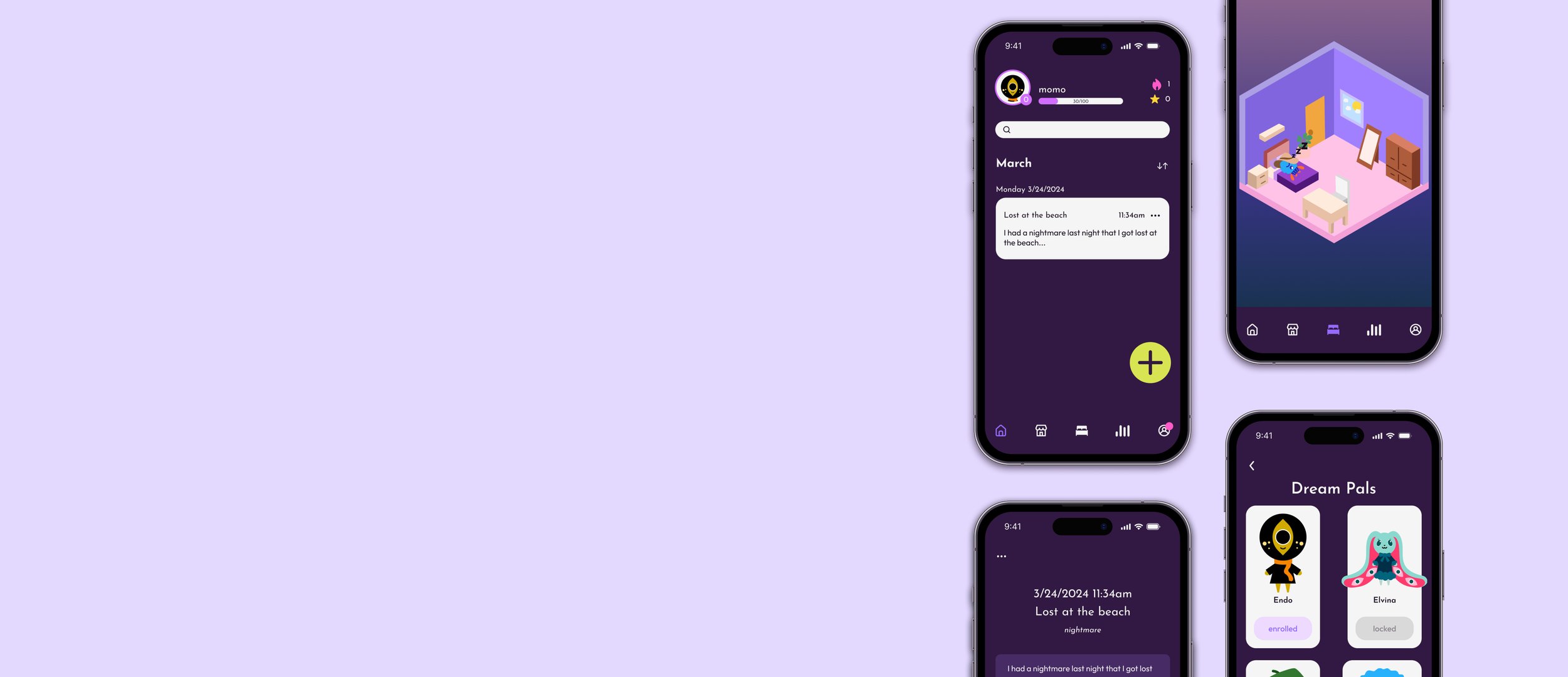
Dreamcore
Log your dreams and collect characters!
At-a-Glance
For my senior year, I had to come up with a senior project using the skills I’ve been taught throughout college. I decided to base my senior project around dream journaling because that was a hobby I used to do throughout my high school years. That’s how Dreamcore came about.
Dreamcore helps users log their dreams daily to gain insight, improve creativity, and enhance dream recall skills by using a gamified experience, unlike Oniri, which does not apply gamification to their product.
Timeline
10 Months
My Role
UX/UI Design
Graphic Design
Tools
Figma
Procreate
Illustrator
InDesign
Team
Kamille Estrella
Problem
The benefits of keeping a dream journal include improved memorization skills, enhanced creativity, problem-solving skills, and the ability to recognize patterns within oneself. However, the main issue with dream journaling among individuals is maintenance. Many find it challenging to journal their dreams consistently due to forgetfulness and limited time after waking up. Additionally, some individuals perceive dream journaling as a chore rather than a hobby.
Therefore, how can people be consistent in logging their dreams immediately after waking up?
Solution
Dreamcore is a dream journaling app that helps users establish a dream journaling routine by providing a gamified experience and utilizing AI features. Users can earn rewards and unlock achievements, all while uncovering insights about themselves, promoting creativity, and enhancing dream recall skills.

Design Process
Discover
Survey
Interview
Analysis
Persona
Empathy Map
Journey Map
Storyboard
User Testing
Feedback
Final UI Comp
Branding
Logo
Character Design
UI Workflow
Information Architecture
Interaction Model
Prototype
Sketches
Low Fidelity Wireframes
Medium-High Fidelity Wireframes
Discover
Survey
I conducted an online survey to gain a clear understanding of my target audience and their challenges. I shared the survey on a subreddit community called r/dreams and on Instagram. From this survey, I received 81 submissions. The survey comprises a combination of Likert-scale and short-answer questions. It is divided into three categories:
Category 1: Have Dream Journaled
In this category, I've discovered that respondents do not document their dreams on a daily basis due to limited time in the morning and forgetfulness. Furthermore, respondents interpret their dreams but are unsure of what to look for or how to do so.
Survey Question: What’s your purpose for documenting your dream?
Dream Interpretation
“Usually to visually represent something or a feeling I am already aware of. I frequently discuss my dreams with a parent or friend who can help further interpret, but only if it’s a super meaningful dream.”
To remember dreams better
“It seems to help my dreams become more vivid and helps me remember them, which is why I try to document them if I remember.”
Casual reasons such memory keeping or sharing with others
“I like sharing them with friends and being able to recall a particular dream.”
“Keeping note of what happened. It depends if I like the dream or if something crazy happens then I’m like yea I gotta write this down or type it in my notes app.”
Creative Inspiration
“I'm a writer, and sometimes I have complex dreams, so I document it to see if I can turn it into a story.”
Another important information I gathered is respondents stated that they only write down dreams that are significant to them.
“Mostly for reflection, but also because I keep hoping it will help me remember them better. So far I have noticed no changes but I do not consistently record my dreams — only when I remember AND they’re significant.”
Category 2: Wants to Dream Journal
Respondents who wish to start dream journaling expressed that they want to remember their dreams and learn how to interpret them. Unlike the respondents in the previous section, these respondents indicated that they can journal their dreams immediately upon waking up.
Survey Question: Why do you want to start documenting your dreams?
Dream Interpretation
“Link certain types of dreams to emotional/physical/environmental situations happening in real life at that time.”
To remember dreams better
“I want to start documenting them to help me remember everything the happened.”
Category 3: Haven't Dream Journaled
In this last category, the majority of the respondents are not interested in dream journaling because they find it insignificant. However, a small percentage of respondents indicated an interest in dream journaling, explaining that they would like to explore the meanings behind their dreams.
Survey Question: Is there a reason you don’t document your dreams? If so, why?
“I don’t really remember my dreams and if I do I don’t see the point in doing so.”
Survey Question: If you'd like to start documenting your dreams, what do you want to gain out of it?
“To find out if there is a meaning or to find out if there are linking dreams.”
Interview
I conducted five interviews, which were divided into two sections: those who have journaled their dreams and those who have not.
Those who have dream journaled
There are two types of people who dream journal: dream interpreters and casual dream journalers.
Dream interpreters tend to recognize patterns more compared to the casual dreamer.
Casual dreamers document their dreams for memory keeping, sharing with others, or simply for fun. They typically do not analyze their dreams but may notice patterns such as recurring dreams or themes.
Has keeping a dream journal had any unexpected benefits or surprises that you didn't anticipate when you started?
"...it’s also fun to interpret even if I don’t know what it means. I like talking about it with friends and hearing about other people's dreams. I think it’s a fun topic to start a conversation."
"I just type my dreams for fun. I don’t try to analyze and see the correlation between the two."
Those who haven’t dream journaled
Participants who have not journaled their dreams express interest in learning how to do so. However, what's stopping them from dream journaling is how tired they are and the limited time they have in the morning. Nonetheless, they do recognize patterns in their dreams but lack understanding of their significance, wanting insight into the meaning behind their dreams.
What factors or circumstances might influence your decision not to write down your dreams?
"So I go to bed super late so my REM sleep is at like 6AM. So when I wake up I have to immediately get ready for school or something. I get all tired and use my phone to wake myself up."
"I’m too tired and lazy and then like by the time I wake up, I forget my dreams."
Analysis
Based on my research data, I discovered three different types of users: the casual dreamer, the interpreter, and the creative. I developed personas for each type, and each persona has its own empathy and journey map to understand their wants, needs, goals, and pain points.
Persona
Empathy Map
Journey Map
Storyboard
I illustrated a storyboard to demonstrate the user's experience using the solution, the Dreamcore app. This process helps me understand the user’s journey with the product, identify design flaws, and assess if the experience makes sense.
UI Workflow
Information Architecture
I created an information architecture to organize the navigation and usability of the application. This helps me understand which features belong under each section and assists me in the design process.
Interaction Model
I developed an interaction model to understand how users would interact with the Dreamcore app while creating their dream entry. This serves as the foundation for the application and helps me create sketches for wireframes.
Prototype
Sketch
I brainstormed ideas for the screens by illustrating rough sketches on Procreate before translating them into wireframes. These sketches reflect the interaction model and information architecture, allowing me to focus primarily on the important screens.
Low Fidelity Wireframes
Before developing high-fidelity wireframes, I created low-fidelity wireframes to get an idea of how I would like the app to look in terms of color palette, typography, and design elements such as buttons and icons.
Onboarding
Reward
Home
Dreamspace
Write Entry
Shop
Interpreting Dream Entry
Profile
Completed Entry
Dream Trends
Medium High Fidelity Wireframes
Afterwards, I improved the low-fidelity sketches by adding more elements and enhancing the structure. I ensured the colors complemented each other, tested the typography within the app, and simulated screen navigation. This made the design more finalized for user testing.
Quiz
Achievements
Home
Dream Pals
Write Entry
Dreamspace
Completed Entry
Shop
Interpreting Dream Entry
Dream Trends
User Testing
Feedback
After completing the medium to high-fidelity wireframes, I conducted 9 user testings to receive feedback for my mobile UI design, navigation and gamification.
Issue 01: Buttons were too small
On the Home screen, users discovered that the icons in the navigation bar and the add button were too small. Additionally, selecting the type of dream ("Dream" or "Nightmare") on the Write Entry screen was challenging.
Issue 02: No "Next" button or answer indication on the quiz screens.
A user suggested adding an additional screen during the Quiz screens with a "Next" button. This would allow them to change their answers without needing to go back to previous screens. They also mentioned the importance of being able to review their selected answer before moving to the next question, ensuring they have chosen the correct option.
Issue 03: No spacing or clear separations in the Reflection Prompt and Final Entry
Users noted that on the Reflection and Completed Entry screens, the lack of spacing between elements makes them hard to distinguish. Some users felt overwhelmed by the dense presentation of information. Additionally, for the tags in the Completed Entry, they suggested assigning each theme a distinct color to enhance visibility.
Issue 04: Buttons look too similar
Users found it difficult to distinguish between the "Enrolled" or "Equipped" and "Locked" buttons on the Characters screen due to their similarity. This issue also affects the List of Achievements and Select Dreamspace screens. They suggested using different colors to make them easier to tell apart.
Issue 05: Shop items lack organization
Users requested an organizing feature in the Shop screen to make finding items easier and to sort them by price, from least to most expensive.
Issue 6: Unclear section meanings in Dream Trends
A user suggested adding descriptions for each section on the Dream Trends screen to clarify their meanings.
Branding
Logo Design
I created an information architecture to organize the navigation and usability of the application. This helps me understand which features belong under each section and assists me in the design process.
Final Logo
Character Design
While designing the characters, I used my personas as a starting point. The three main characters in the project are Endo the Analyzer, Creo the Creative and Elvina the Casual Dreamer. I also designed two additional characters, August and Meeps, for the app’s prototype to showcase how a user can earn and use a character.
Overall,
I thoroughly enjoyed working on this project during my senior year. While there were times I felt my designs were not meeting my expectations due to the pressure I placed on myself and the rush to complete tasks, this experience taught me the importance of taking things slow and being patient. Working on a project I am passionate about has been incredibly rewarding, and it is an experience I will never forget.


























































